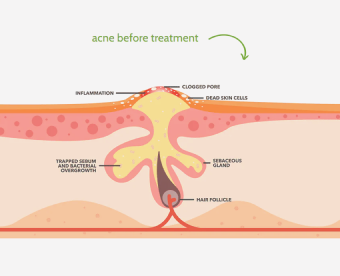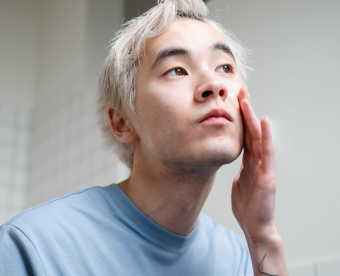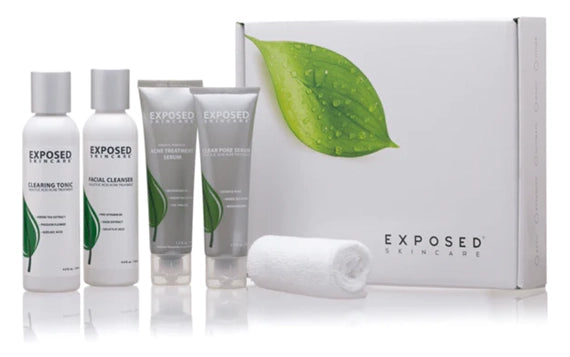One of the questions we often hear people ask is, "Do silk pillowcases help with acne?" It seems like an unexpected link—your pillowcase and acne. After all, what could be the possible connection between a simple item from your bedroom and a complex skin condition? But, as it turns out, the answer might be a bit more complex than you'd think.
Silk pillowcases have gained a reputation as a secret weapon in the fight against acne, touted as the best pillowcase for acne-prone skin. But is this merely a marketing ploy, or is there truth behind it?
This blog will dissect the topic, separating facts from myths to help you make an informed choice. So, if you've been debating whether to switch from your regular pillowcase to a silk one, keep reading.
Also read: How to choose the best acne treatment
Biggest Take-Aways:
-
Due to their smooth texture and non-absorbent nature, Silk pillowcases can benefit people with acne or sensitive skin by reducing friction and maintaining the skin's natural oils.
-
Despite the possible benefits, silk pillowcases are not guaranteed acne solutions. Their effect can vary widely from person to person, and they should be considered as part of a broader skincare routine.
-
The quality of silk in pillowcases can greatly differ, with 100% mulberry silk being the best choice. The care and upkeep of silk pillowcases also require more attention.
-
Integrating an effective skincare routine with products like Exposed Skin Care, specifically formulated to manage acne, can help optimize results when paired with silk pillowcases.

The Relationship Between Your Pillowcase and Acne
Acne is a multifaceted skin issue, often triggered by factors such as diet, hormones, stress, and, yes—even your pillowcase. So, why exactly does your pillowcase matter?
Much like a petri dish, your pillowcase can harbour a host of bacteria, dirt, oil, and dead skin cells you shed every night. These microscopic particles can penetrate into your pores, clogging them up and triggering acne breakouts.
This is where the material of your pillowcase comes into play. Not all materials are created equal when keeping your skin clear and healthy.
The Battle: Cotton Vs Silk Pillowcase
Cotton is the most commonly used material for pillowcases. However, cotton is highly absorbent, which means it can draw out and retain the natural oils (sebum) from your skin and hair. This can result in dry skin and lead to a buildup of oil, dirt, and bacteria on the pillowcase surface.
On the other hand, we have the highly touted silk pillowcase. Silk is smooth, less absorbent, and gentler on the skin. A natural silk pillowcase, especially one made from 100% mulberry silk, is known to cause less friction and irritation. But does this make silk pillowcases good for acne? Let's delve deeper.
Do Silk Pillowcases Help with Acne?
Silk pillowcases have numerous qualities that make them a potentially better choice for people with acne or sensitive skin. Here's why:
Silk Pillowcases Are Gentle
Silk pillowcases are gentle on your skin due to their smooth texture. Silk fibres are tightly woven, resulting in a soft, smooth surface that reduces friction. This can be particularly beneficial for people with acne-prone skin, as less friction means less irritation and potentially fewer breakouts.

Silk Pillowcases Are Less Absorbent
Unlike cotton, silk doesn’t absorb as much moisture. This means your skincare products stay on your skin, where they can work their magic, instead of being absorbed by your pillowcase.
Silk is Naturally Hypoallergenic
Silk is naturally hypoallergenic, meaning it's less likely to cause allergic reactions. This can be beneficial for sensitive skin and for those prone to breakouts. Additionally, silk's natural properties may help keep dust mites at bay, further preventing skin irritation.
Silk May Keep Your Skin Cooler
Silk may also help keep your skin cooler during the night. Excessive heat and sweating can exacerbate skin issues like acne, making silk a potentially better option for those prone to breakouts.
While these points make a compelling case for silk pillowcases, they aren't the definitive answer to the question, "do silk pillowcases help with acne?"

The Role of Exposed Skin Care in Managing Acne
While silk pillowcases may provide a smoother, cooler surface that's gentler on acne-prone skin, it's crucial to supplement this with an effective skincare routine. This is where Exposed Skin Care comes into play.
Here are a few benefits that make it a valuable addition to your skincare routine:
-
It employs a dual approach: While many products merely focus on clearing existing acne, Exposed Skin Care works to both clear existing breakouts and prevent new ones.
-
Formulated with acne-prone skin in mind: The products are designed to be gentle on sensitive skin, preventing further irritation that could trigger acne.
-
Incorporates natural and scientific ingredients: Combining natural extracts like green tea and passionflower with scientifically proven ingredients like benzoyl peroxide and salicylic acid helps maintain the skin's balance.
By integrating Exposed Skin Care into your routine, alongside using a silk pillowcase, you can create an optimal environment both on and off the skin, potentially reducing the frequency and severity of acne flare-ups. This multi-faceted approach could be the key to achieving healthier, clearer skin.
Conclusion
The world of skincare is complex, filled with countless variables that can influence the health and appearance of our skin. One such variable is the type of pillowcase we sleep on, specifically whether a silk pillowcase can help with acne.
From a smoother surface that reduces friction to less absorbent, thus maintaining the skin's natural oils, silk pillowcases undoubtedly offer potential benefits for those battling acne or sensitive skin. However, they are not a miracle solution to acne—a complex skin condition influenced by many factors.
In addition to the material of your pillowcase, a holistic skincare routine is of utmost importance. Topical skincare treatments, such as Exposed Skin Care, can be critical in managing acne. Formulated to both clear existing breakouts and prevent new ones, it offers an effective and well-rounded approach to skincare.
In the end, silk pillowcases might benefit your skincare strategy, but they aren't a standalone solution. As with all things related to skin health, a comprehensive approach that addresses various factors will yield the best results.
The journey to clearer skin might involve multiple steps, from the type of pillowcase you use to the skincare products you apply, but each step brings you closer to healthier, happier skin.
FAQs
Q: How often should I wash my silk pillowcase?
A: Silk pillowcases should ideally be washed at least once a week to ensure they remain clean and free of oil, skin cells, and bacteria.
Q: Are silk pillowcases beneficial for other skin issues?
A: Besides potentially helping with acne, silk pillowcases are believed to prevent fine lines and wrinkles due to less friction. They are also a popular choice for people with dry or sensitive skin.
Q: Are all silk pillowcases the same?
A: No, the quality of silk pillowcases can vary greatly. When choosing a silk pillowcase, look for those made from 100% mulberry silk for the best quality.


















